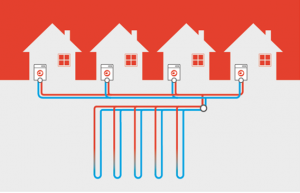How do they work?
A Ground Source Heat Pump (GSHP) circulates a mixture of water and antifreeze around a loop of pipe which is buried in your garden, either in a horizontal trench around 1-2m deep, or within a vertical borehole(s) around 100m deep. The heat from the ground is absorbed into the water and passes through a heat exchanger and compressor within the heat pump. This raises the temperature and heats the hot water and central heating circuits of the house. The cooled ground loop water is returned back into the ground to re-absorb more heat in a continuous cycle. Because the ground stays at a fairly constant temperature, the heat pump can be used all year round. Borehole systems tend to be more efficient (and cheaper to run) than horizontal loops because the ground stays warmer at greater depth, they also require less space. However it’s more expensive to drill boreholes than dig horizontal trenches. Heat pumps do require electricity to run the pumps and compressor, so aren’t 100% renewable, but they can produce up to 5 times the amount of heat for each kW of electricity used.
Benefits:
- Could lower your fuel bills, particularly if you’re replacing electric or oil heating systems
- You could receive an income from the Government’s Renewable Heat Incentive (RHI)
- Will lower your homes carbon emissions if you’re replacing a traditional fossil fuel heat source
- Can completely replace a boiler; providing heat for your home and hot water
- Once installed, minimal maintenance is required. The life span of most heat pumps is 20-25 years. The ground loops will last much longer than this.
THE DOMESTIC RHI IS ONLY GUARANTEED UNTIL MARCH 2021
FAQ’S
How much space will I need for a horizontal ground loop?
This will depend on a number of factors, such as ground type, location, size of property, and insulation levels. As a guideline, the horizontal ground loop area is typically around 3 times the total floor area of the property. If you don’t have space for this, then a vertical borehole(s) is an option, as these only need space for the drilling machinery to operate.
What size heat pump do I need?
Again, this will depend on a number of factors, most importantly property size and insulation levels. Most typical domestic properties require a heat pump in the range of 5-12 kW. Heat pumps work best when producing lower temperature heat than traditional boilers, so it’s important that your home is well insulated. This will also reduce the size of the heat pump required, saving you money.
Are heat pumps noisy?
Ground source heat pumps are almost always quieter than a fossil fuel boiler. Typically they have the same sound levels as a domestic refrigerator.
Can a GSHP provide all of my heat and hot water all year round?
Yes. A correctly designed system will supply all of the heat and hot water demands all year round.
What is the CoP of a heat pump?
The Coefficient of Performance (COP) is a measure of how efficient the heat pump is. A COP of 4 means that for every 1 unit of electricty used, the heat pump will produce 4 units of heat. Ground source heat pumps can have CoP’s of greater than 5.
HAVE ANY OTHER QUESTIONS? CONTACT US
GSHP District Heating

How does it work?
A series of ground loops, typically boreholes, are linked together to form a shared ground array acting as a heat energy source to multiple properties (District Heating) or multiple occupancy buildings (Communal Heating). The shared ground loop system transfers heat energy from the ground to individual ground source heat pumps located inside each individual dwelling.
Benefits:
- Drilling costs are reduced by allowing a smaller number of deeper boreholes.
- Boreholes can be positioned flexibly across the site, rather than restricted to each individual property
- Independent billing – Each heat pump is wired to its own electricity supply, providing end users with complete heating control and freedom to shop around for energy deals, whilst also negating issues of split-billing.
- Low heat losses – each heat pump generates usable heat at the point of use.
- 20 year income from the non-domestic RHI scheme, and return on investment for the developer
- Suitable for new build developments or for retrofit to existing properties.

